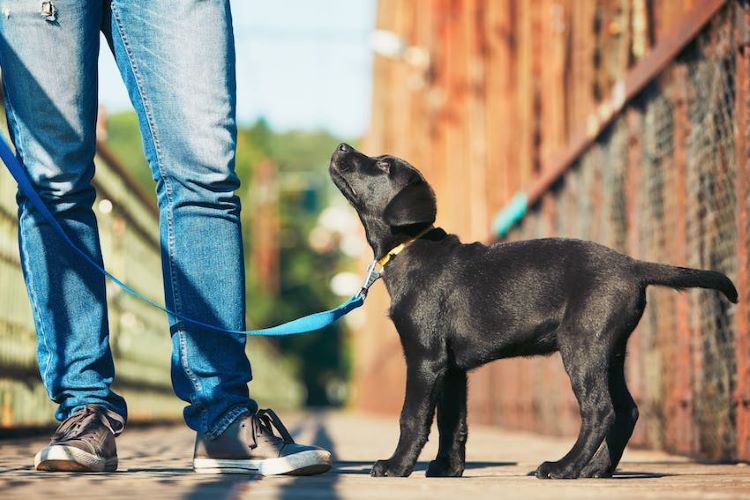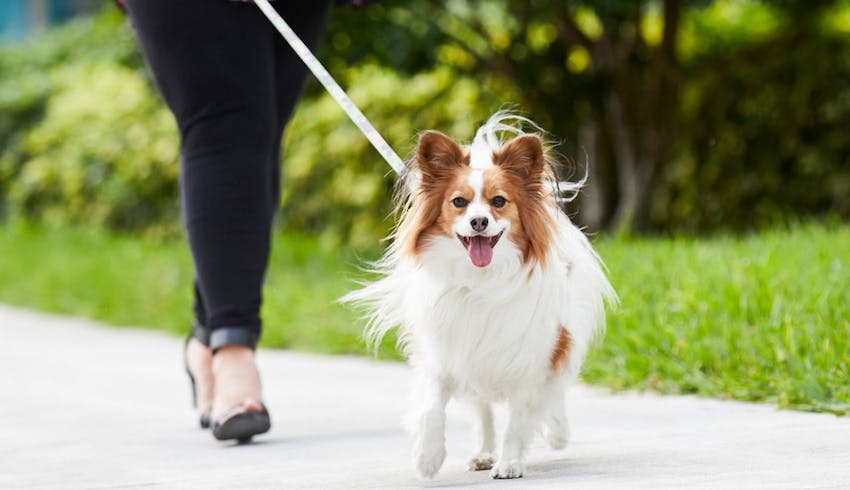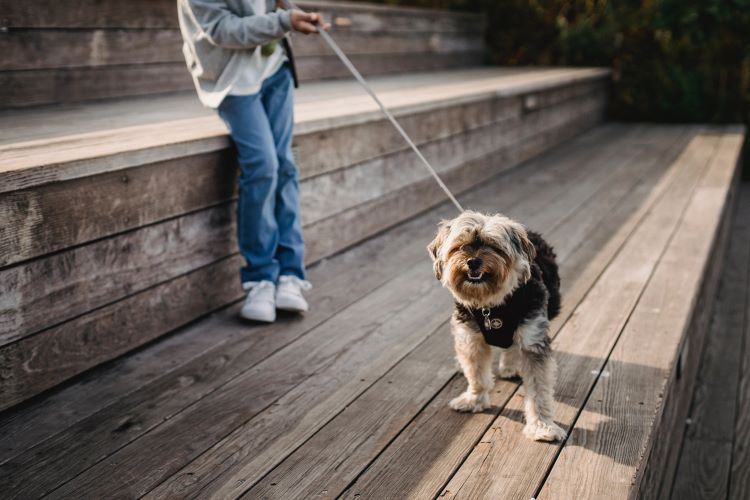Ready to help treat your pet to a healthy life?
How to Leash Train a Puppy
By : Kelli Rascoe & Trupanion Staff | Updated Feb 18, 2025

You probably already have a leash as one of your essential new puppy supplies, but are you using it properly with your pet? Leash training a puppy is one of the most important tasks for any new dog owner to take on. After all, a dog that walks calmly and obediently on a leash in public is a safe dog. And not only does proper leash training ensure the safety of your furry friend (and those around them), but it can also enhance the bond between you and your pup.
For many puppy parents, of course, leash training seems a lot easier said than done. Fortunately, every puppy is capable of learning how to use a leash properly, and with the right knowledge, every pet owner can teach this vital canine skill.
Do I really have to train my dog on a leash?
Yes! Puppy leash training can go overlooked due to many pet owners assuming that just having a leash on a dog is doing the work. Some also make the mistake of thinking their pet is too young to learn or that they will naturally grow out of unsafe behavior like pulling on a leash, biting it, or trying to wriggle out of it. Unfortunately, not curbing this behavior during puppyhood makes it more difficult to do so later on. Allowing dogs to act this way creates an unsafe environment for both themselves and others.
There are several key advantages of leash training a dog properly from the get-go:
- Preventing unwanted behavior — Puppy leash training helps discourage undesirable behaviors such as excessive pulling, jumping, and wandering off. It helps establish important boundaries and encourages your pet to stay better behaved off-leash as well.
- Exercise — Dogs of all breeds require daily exercise and benefit from regular walks. Proper leash training makes it easier to bring your pup out on walks and stay out longer.
- Putting others at ease — Many people are uncomfortable around dogs that are straining against their leashes and pulling away from their owners. Having a calm, obedient, and confident dog on a leash helps put others around you at ease and is often a requirement for being allowed into certain public spaces.
- Control in emergency situations — Anything can happen when you're out with your pet. Having a properly leash-trained dog allows you to quickly and safely guide them (and yourself) away from potential hazards.
- Easier veterinary visits — Leash training helps veterinary visits be less stressful, making it easier for you to bring your pet to their appointments as well as help vet staff carry out examinations and treatment.
- Stronger pet-owner bond — Leash training offers a chance for you and your puppy to spend quality time together while participating in a shared activity. By teaching them to walk beside you, respond to commands, and follow your lead, you establish yourself as a trusted leader and foster a sense of camaraderie.
- More pleasant walks for humans and pets alike — Leash training helps transform walks from potentially stressful experiences to enjoyable outings. A well-behaved, leash-trained puppy allows you to relax and savor the time spent outdoors with your pet.
When is the right time to start leash training your puppy?
New puppies are exciting additions to families small and large, but they also require a lot of work. Along with making sure you have all the essential supplies for your new puppy, it's important to start training early on. As we've established, proper puppy training is essential for raising a well-mannered, socialized pet. So, when exactly should you start teaching a puppy to use a leash?

Generally, it's advisable to start leash training when your puppy is between 8 and 12 weeks old. At this age, they are more open to learning and can easily adapt to new experiences. However, remember that each puppy is unique, so it's important to take into account their individual needs and abilities.
There are a few signs that suggest your puppy is ready for leash training. Look for signs of curiosity and enthusiasm when you bring out the leash. If your puppy shows interest in going outside or gets excited when they see other dogs being walked, these are positive indicators that they are ready to start leash training. Additionally, if your puppy can follow basic commands such as sitting or coming when called, they are likely to be more receptive to leash training.
Tips and essential tools for getting started
Before you get started on puppy leash training, it's a good idea to make sure you have some basic items and know-how in place. These include:
- Selecting the right leash and collar — When choosing a leash and collar for your puppy, it's important to consider their size, breed, and comfort. A standard dog harness or leash made of nylon or leather is a good choice for most puppies. Opt for a fit that's not too tight or too loose and can be adjusted as your puppy grows.
- Positive reinforcement techniques — Positive reinforcement is a powerful tool in leash training. Reward your puppy with treats, praise, and affection when they exhibit good leash manners. For example, when your puppy walks calmly by your side, give them a treat or verbal praise. This positive association will encourage them to repeat the desired behavior.
- Proper leash handling — Proper leash handling is crucial for successful leash training. Hold the leash with a relaxed grip, keeping it short enough to maintain control but not so tight that it restricts your puppy's movement. Avoid pulling or yanking the leash, as this can cause discomfort and lead to leash-related issues.
Remember, patience and consistency are key when leash training your puppy. Make sure to practice in low-distraction environments initially and gradually increase the level of difficulty as your puppy becomes more comfortable. With time and practice, your puppy will become a pro at leash walking!
9 steps for leash training a puppy
Follow this step-by-step guide to successfully train your puppy on a leash. Remember, few dogs will get the hang of things right away. The key is to stay consistent!
- Start by letting your puppy get used to the feel of the collar. Put the collar on the puppy while at rest or when it’s distracted with a toy or treats. Use positive reinforcement and reward them with pats and treats for wearing the collar.
- A slow introduction to the leash is key to making the training process positive and successful. Like the collar, start leash training by simply letting your puppy explore the leash without any pressure. Let them sniff it, play with it, and get used to its presence. This helps them associate the leash with positive experiences and reduces any fear or resistance they may have.
- Practice walking with your puppy on the leash inside. If the puppy is reluctant to walk with you, use treats to help coax them to walk with you. Try taking a few steps at a time. Call the puppy try taking a couple of extra steps to encourage them to walk with you. Avoid dragging or yanking them on the leash.
- When your puppy is used to walking on the leash inside, take them outside. Have treats with you to encourage them to pay attention and walk with you. Keep initial walks short and remember to use positive reinforcement.
- Practice basic dog commands while your puppy is on leash, including "sit" and "stay."
- When your puppy gets distracted, use treats or toys to encourage them to focus on you.
- Reward your puppy with treats and praise for walking next to you. Create positive association with good behavior.
- Gradually increase the length of your walks.
- Be patient and consistent. Every puppy is different — some require more time while others take to walking on a leash with no problem. It's important to stay consistent and only gradually introduce your pet to new places and longer walk times as they become more confident and well behaved.
Get more tips for new puppy parents to promote your pet's safety and well-being.
Additional advice for successful leash training
- Keep initial sessions short.
- Don’t ever yank or jerk the leash.
- Different dogs have different needs. There are lots of options to make walking more pleasurable for both you and your pup. Consider a harness or a gentle leader to help guide your pet outside.
- Use positive reinforcement. Positive reinforcement is more effective than negative reinforcement and can help build the bond between you and your new pup.
- Don’t be afraid to enlist the help of a dog trainer. Reputable trainers can make the process much easier if you are encountering any difficulties, or if you just aren’t certain you are doing the right things. Ask your veterinarian what trainers in the area they recommend.
- Avoid retractable leashes, as they can cause injury and encourage bad behavior (like pulling too far ahead).
Make puppy safety a priority
Leash training is an essential skill that benefits both you and your puppy. By starting early, using positive reinforcement, and maintaining consistency, you can create an enjoyable and safe walking experience for your furry companion. With patience and dedication, you'll soon have a well-trained puppy that walks confidently by your side. But while you're exposing your pet to more of the world, it's important to make sure you're making their safety a priority and keeping them properly protected.

Always bring along plenty of water on walks, and avoid any dogs who are pulling aggressively on their leashes or appear to be otherwise untrained. You can't predict when accidents will happen or where, so you'll also want to protect your puppy with a good dog insurance plan while they're still young.
Wondering what else you should be teaching your puppy during the early months of their life? Here's a whole list of puppy training you shouldn't skip.
